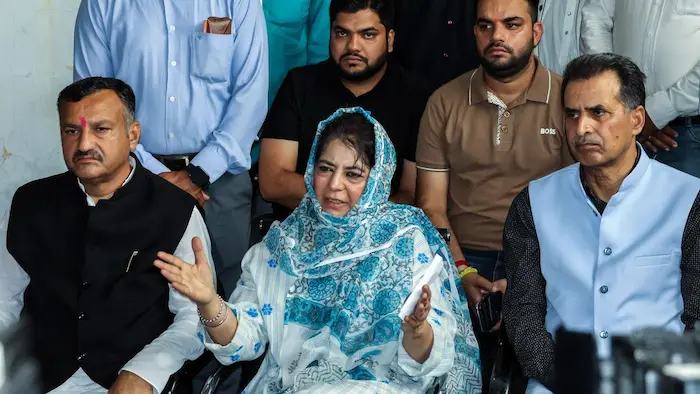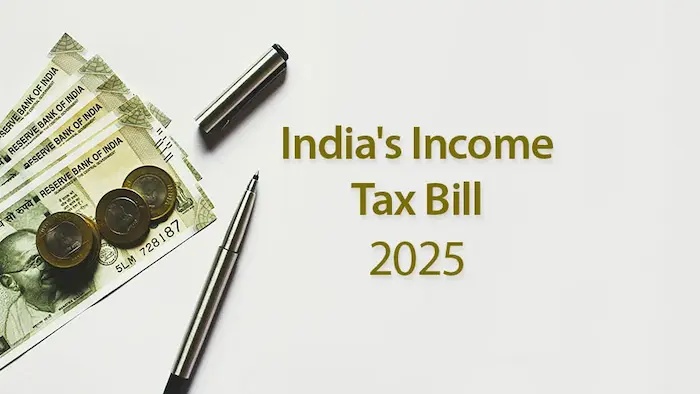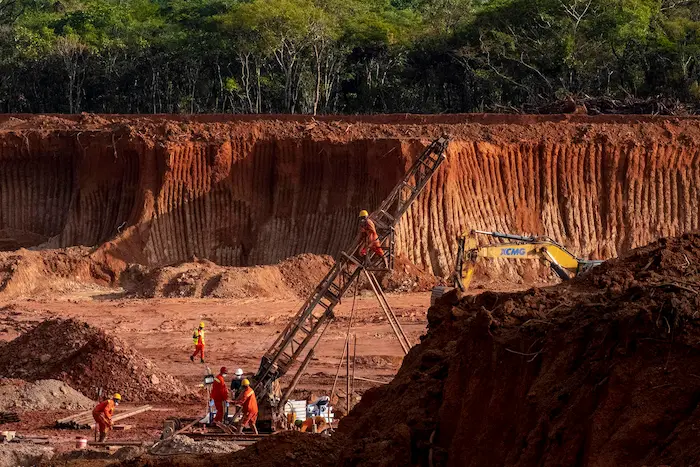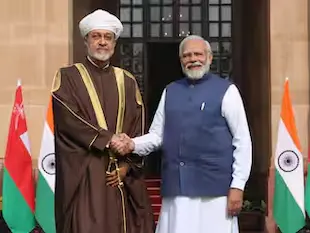1. Jammu & Kashmir: Lieutenant Governor’s Power to Nominate Assembly Members – Polity

Why in News?
- The Ministry of Home Affairs (MHA) told the J&K High Court that the Lieutenant-Governor (L-G) can nominate five members to the Legislative Assembly without consulting the elected government.
- This has raised constitutional concerns about democratic accountability in J&K’s governance structure.
Core Constitutional Issue
- Can the 2023 amendments to the J&K Reorganisation Act, 2019, which empower the L-G to nominate 5 members, be considered a violation of the basic structure (democracy, federalism, representative government)?
- Could such nominations alter Assembly dynamics, potentially overturning the electoral mandate?
2023 Amendments – Key Provisions
- Sections 15A & 15B: Criteria for nomination (meant to ensure representation of certain groups).
- Total Assembly Seats: 119 members (114 elected + 5 nominated).
- Voting Rights: Nominated members enjoy full voting rights, not just advisory roles.
Centre’s Justification
- Relies on K. Lakshminarayanan vs Union of India (2019) → where SC upheld L-G’s power to nominate members in Puducherry.
- Refers to Union Territories Act, 1963 (Section 12) → defines “sanctioned strength” to include nominated members.
- MHA emphasizes legal technicalities over broader democratic implications.
Concerns Regarding Democratic Implications
- Risk of Mandate Distortion
- 5 unelected members could decide the fate of governments in a closely divided Assembly.
- Puducherry Precedent (2021)
- Nominated members and defections led to the fall of the Congress-led government.
- Fear of similar destabilisation in J&K.
- J&K’s Context
- Transition from State → Union Territory (2019) happened without elected Assembly consultation.
- Adds to concerns about democratic deficit and central overreach.
Supreme Court Jurisprudence on L-G’s Powers
| Case | Principle |
|---|---|
| NCT of Delhi vs Union of India (2018 & 2023) | L-G must act on aid & advice of elected government; discretion is exceptional. |
| Puducherry Case (2019) | Allowed L-G to nominate without consultation – but in a much smaller UT legislature. |
Tension: MHA’s stance in J&K seems inconsistent with Delhi rulings that favour primacy of elected governments.
Way Forward
- Judicial clarity → HC & SC must determine if 2023 amendments violate basic structure doctrine.
- Checks & balances → Nomination process should involve consultation with elected government.
- Transparency → Clear, non-political criteria for nomination to avoid misuse.
- UT Governance Reforms → Ensure that representation + accountability go hand in hand.
Exam Connect – Possible Questions
Prelims
- Under the 2023 amendments to the J&K Reorganisation Act, how many Assembly members can the L-G nominate?
A. 3
B. 5
C. 6
D. 9
Answer: B. 5 - Which Supreme Court case clarified that the L-G should act on the aid and advice of the elected government, except in rare cases?
A. Kesavananda Bharati vs Union of India (1973)
B. NCT of Delhi vs Union of India (2018, 2023)
C. K. Lakshminarayanan vs Union of India (2019)
D. SR Bommai vs Union of India (1994)
Answer: B. NCT of Delhi vs Union of India (2018, 2023)
Mains
- Critically examine the constitutional and democratic implications of the Lieutenant-Governor’s nomination powers in Jammu and Kashmir’s Assembly.
- How does the J&K nomination issue highlight the tension between Union oversight and democratic accountability in Union Territories?
- Discuss the significance of the Supreme Court’s jurisprudence on L-G powers in Delhi and Puducherry. How should these precedents shape governance in Jammu and Kashmir?
2. New Income Tax Bill, 2025: Towards a Simplified and Modern Tax Regime – Economics

Why in News?
- The Income-tax Bill, 2025 was passed by Parliament.
- It will replace the Income-tax Act, 1961 and will come into effect from April 1, 2026.
- The Bill seeks to simplify, modernize, and streamline India’s direct tax system.
Key Objectives
- Simplification → Easier for taxpayers to understand & comply.
- Modernisation → Removal of outdated provisions and language.
- Streamlining → Reduction in total sections from 819 → 536.
Important Features of the New Income Tax Bill, 2025
| Provision | Key Reform |
|---|---|
| Refunds on Belated Returns | Restores ability to claim refunds even if returns filed late (earlier restricted). |
| TCS on LRS Remittances | No Tax Collected at Source (TCS) for education abroad funded by financial institutions. |
| Corporate Tax | Fixes issues in inter-corporate dividend deductions under concessional tax regime. |
| Alternate Minimum Tax (AMT) | Brings AMT for LLPs in line with existing corporate tax rates. |
| Nil TDS Certificate | Taxpayers with no liability can obtain a Nil-TDS certificate (reduces cash flow issues). |
| Transfer Pricing | Clearer rules on set-off of losses and alignment with beneficial ownership (Sec. 79). |
| Non-Profit Organisations (NPOs) | Exemption limit expanded to 5% of total donations (earlier only anonymous donations). |
| House Property Income | 30% standard deduction allowed after municipal tax payment. |
| Search Definition | Includes virtual digital space (cloud, emails, social media) for searches. |
| Data Handling | New SOPs for digital data seized during searches → stronger data privacy safeguards. |
Why This Reform Matters
- Ease of Doing Business: Simplifies compliance for businesses & individuals.
- Investor Confidence: Predictable & modern tax framework boosts foreign investment.
- Digital Era Relevance: Recognises cloud & digital assets in tax searches.
- NPO Sector Growth: Expands tax benefit scope, encouraging philanthropy.
- Taxpayer-Friendly: Refunds restored, nil-TDS option available.
Challenges Ahead
- Implementation & training of tax officials on new law.
- Balancing tax simplification with revenue mobilisation.
- Ensuring clarity in interpretation to avoid litigation.
- Integrating provisions with digital tax administration (faceless assessment, AI-based scrutiny).
Global Best Practices Incorporated
- Similar to OECD countries: reduced complexity, clarity in transfer pricing, and digital asset recognition.
- Moves India closer to globally competitive tax systems.
Exam Connect – Possible Questions
Prelims
- The Income-tax Bill, 2025 seeks to replace which of the following legislations?
A. Income-tax Act, 1956
B. Income-tax Act, 1961
C. Direct Taxes Code, 2010
D. Fiscal Responsibility Act, 2003
Answer: B. Income-tax Act, 1961 - Which of the following is a new feature under the Income-tax Bill, 2025?
- Refunds can be claimed on belated returns.
- Nil-TDS certificate allowed for taxpayers with no liability.
- Tax exemption for NPOs raised to 5% of total donations.
A.1 and 2 only
B. 2 and 3 only
C. 1 and 3 only
D. 1, 2 and 3
Answer: D. 1, 2 and 3
Mains
- Discuss the key features of the Income-tax Bill, 2025. How does it aim to simplify and modernise India’s tax framework?
- Critically analyse the impact of the Income-tax Bill, 2025 on ease of doing business, taxpayer compliance, and digital-era taxation.
- The Income-tax Bill, 2025 is a step towards aligning India’s taxation with global best practices. Evaluate this statement.
3. UNDP Equator Initiative Prize, 2025 – International Relations

Why in News?
- A collective of women farmers from Karnataka has been awarded the UNDP Equator Prize 2025,
- They are among the ten global winners, recognised for their community-led efforts in biodiversity conservation and sustainable livelihoods.
About the UNDP Equator Prize
| Feature | Details |
|---|---|
| Launched by | UNDP’s Equator Initiative |
| Frequency | Biennial (every 2 years) |
| Nickname | “Nobel Prize for Biodiversity Conservation” |
| Prize Money | USD 10,000 |
| Purpose | Celebrates community-based initiatives that link poverty reduction with biodiversity conservation |
| Eligibility | 1. Must exist for ≥ 3 years. 2. Community-based / Indigenous Peoples’ groups in rural UNDP-supported countries. 3. Nature-based solutions benefiting ≥ 2 SDGs. |
Significance
- Recognises grassroots leadership in addressing climate change, biodiversity loss, and livelihood generation.
- Encourages community-driven conservation models that can be replicated globally.
- Strengthens the link between local initiatives and international recognition.
Back to Basics: UNDP
| Aspect | Details |
|---|---|
| Established | 1966 by UN General Assembly |
| HQ | New York, USA |
| Mission | End poverty, strengthen democratic governance, promote sustainable development, climate resilience, and disaster preparedness |
| Funding | Voluntary contributions from UN member states |
| Flagship Initiatives | – Human Development Index (HDI) – Gender Inequality Index (GII) – SDG Reports |
| Role | Advocates policy change, connects countries to resources, provides technical expertise for sustainable human development |
Link with Sustainable Development Goals (SDGs)
The Equator Prize typically supports initiatives contributing to:
- SDG 1 → No Poverty
- SDG 13 → Climate Action
- SDG 14 → Life Below Water
- SDG 15 → Life on Land
- SDG 5 → Gender Equality (esp. women-led groups like the Karnataka farmers)
Why Important for India?
- Showcases India’s grassroots climate action on a global stage.
- Encourages women’s empowerment in agriculture and biodiversity conservation.
- Strengthens India’s soft power in international climate diplomacy.
Exam Connect – Possible Questions
Prelims
- The UNDP Equator Prize is awarded for which of the following?
A. Innovations in climate technology
B. Community-led biodiversity conservation and poverty reduction initiatives
C. Academic excellence in development studies
D. International climate negotiations
Answer: B. Community-led biodiversity conservation and poverty reduction initiatives - Which of the following is NOT a flagship initiative of the UNDP?
A. Human Development Index (HDI)
B. Gender Inequality Index (GII)
C. World Development Report
D. SDG Reports
Answer: C. World Development Report
Mains
- Discuss the significance of the UNDP Equator Prize in promoting community-led sustainable development initiatives. How does such recognition strengthen global environmental governance?
- Examine the role of the UNDP in achieving Sustainable Development Goals (SDGs). How do initiatives like the Equator Prize complement India’s grassroots development models?
- The Karnataka women farmers’ recognition with the UNDP Equator Prize highlights the importance of community-based conservation. Evaluate the role of local communities in India’s biodiversity and climate action strategies.
4. Africa’s Pushback Against China’s Mining Dominance – International Relations

Why in News?
- For two decades, China has dominated Africa’s mining sector, especially in cobalt, lithium, copper, and iron ore.
- Recently, African governments and civil society groups have begun challenging:
- Lack of transparency in contracts,
- Environmental degradation,
- Absence of local value addition.
- Countries like the Democratic Republic of Congo (DRC), Namibia, and Zimbabwe are now renegotiating deals, banning raw exports, and demanding domestic processing.
China’s Mining Dominance in Africa
| Factor | Details |
|---|---|
| Critical Mineral Control | DRC produces 80% of world’s cobalt, of which China controls ~80% via contracts like Sicomines. |
| Infrastructure-for-Resources Model | Chinese companies built infrastructure (roads, rail, power) in exchange for mineral rights. |
| Local Benefits? | Minimal → Resources extracted and exported, with limited job creation or value addition for African economies. |
Drivers of Pushback Against China
- Civil Society Pressure
- Groups like Congo Is Not for Sale revealed $132M revenue loss (2024) from weak Chinese contracts.
- Market-Linked Risks
- Commodity-linked contracts leave countries vulnerable during price crashes.
- Government Action
- DRC increased stake in Sicomines JV from 32% → 70%, asserting sovereignty.
- Contracts being renegotiated or cancelled to protect national interest.
African Nations’ Assertive Steps
- DRC: Cancelled sale of Chemaf Resources to China’s Norin Mining; expanded local stake in ventures.
- Namibia: Investigating Xinfeng Investments over $50M bribe & failure to deliver promised processing plants.
- Zimbabwe: Concerns over Huayou Cobalt lithium plant ($300M), which may export benefits back to China.
Environmental & Social Concerns
- Pollution: Acid spill in Zambia → Kafue River contamination.
- Biodiversity: Mining permit for Hwange National Park (Zimbabwe) blocked due to ecological risk.
- Communities & Heritage: Lobé-Kribi Iron Ore Project (Cameroon) opposed over health & cultural impacts.
Policy Shifts for Economic Sovereignty
| Country | New Measures |
|---|---|
| Zimbabwe | Ban on export of unprocessed lithium. |
| Namibia | Export restrictions on raw lithium → promote domestic value addition. |
| DRC | Increasing state ownership of mining JVs. |
Objective: Retain more value within Africa through local processing, employment, and industrialisation.
Risk: Without anti-corruption reforms, policies may be captured by political elites.
Why This Matters Geopolitically
- Weakens China’s resource monopoly and opens space for India, EU, and US to strengthen partnerships.
- Links to global critical minerals race (batteries, EVs, renewable energy supply chains).
- Africa asserting economic sovereignty could redefine South-South cooperation and China–Africa relations.
Exam Connect – Possible Questions
Prelims
- Which African country produces around 80% of the world’s cobalt, much of it controlled by China?
A. Zambia
B. Democratic Republic of the Congo
C. Zimbabwe
D. Namibia
Answer: B. Democratic Republic of the Congo - The “infrastructure-for-resources” model is most closely associated with which country’s investments in Africa?
A. USA
B. India
C. China
D. Russia
Answer: C. China
Mains
- Discuss the challenges African nations face in balancing foreign investment in critical minerals with the need for economic sovereignty and environmental protection.
- Examine how Africa’s pushback against Chinese mining dominance could reshape global supply chains in critical minerals. What role can India play in this changing landscape?
5. India–Oman CEPA (Comprehensive Economic Partnership Agreement) Concluded – International Relations

Why in News?
- India has successfully concluded negotiations for a Comprehensive Economic Partnership Agreement (CEPA) with Oman.
- This pact aims to boost trade, investment, and regulatory cooperation between the two nations.
What is CEPA?
- Definition: A Comprehensive Economic Partnership Agreement (CEPA) is a free trade agreement (FTA) with a wider scope.
- Coverage:
- Trade in goods & services,
- Investment,
- Trade facilitation,
- Competition policy,
- Intellectual Property Rights (IPR),
- Regulatory harmonisation.
- Difference from FTA: Broader than a simple tariff-cutting FTA → includes economic cooperation & institutional mechanisms.
India–Oman Bilateral Relations
Strategic Importance
- Diplomatic ties established in 1955; upgraded to Strategic Partnership in 2008.
- Oman’s location (near UAE, Saudi Arabia, Yemen) makes it a gateway to West Asia and the Gulf of Oman/Indian Ocean.
- Strong diaspora ties: ~7.8 lakh Indians live in Oman (largest expatriate community).
Economic & Trade Relations
- Oman is India’s 3rd-largest export destination in GCC (after UAE, Saudi Arabia).
- Bilateral Trade (FY 2024–25): USD 10.61 billion.
| India Exports to Oman | India Imports from Oman |
|---|---|
| Light oils, rice, machinery, metals | Crude oil, LNG, fertilizers, chemicals |
Multilateral Cooperation
- Oman is active in:
- GCC (Gulf Cooperation Council),
- Arab League,
- Indian Ocean Rim Association (IORA).
- Acts as a bridge for India’s outreach in Middle East & Indian Ocean region.
Significance of the CEPA
- For India
- Strengthens energy security (crude oil, LNG imports).
- Boosts Indian exports in manufacturing, agriculture, and pharma.
- Enhances India’s presence in the Gulf and West Asia.
- For Oman
- Diversifies economy beyond hydrocarbons (aligns with Oman’s Vision 2040).
- Gains access to Indian market & investment capital.
- Geopolitical Importance
- Counters China’s influence in Oman (China is Oman’s largest trading partner).
- Enhances India’s connectivity and influence in the IOR (Indian Ocean Region).
Challenges Ahead
- Need for regulatory alignment to avoid non-tariff barriers.
- Possible resistance from domestic industries fearing cheaper imports.
- Ensuring balanced benefits in services & investment, not just goods.
Exam Connect – Possible Questions
Prelims
- Which Gulf country is India’s third-largest export destination after UAE and Saudi Arabia?
A. Qatar
B. Oman
C. Kuwait
D. Bahrain
Answer: B. Oman - Which of the following best describes a Comprehensive Economic Partnership Agreement (CEPA)?
A. A simple tariff-reduction agreement
B. A broader agreement covering trade, services, investment, and regulatory cooperation
C. A military alliance
D. A bilateral investment treaty only
Answer: B. A broader agreement covering trade, services, investment, and regulatory cooperation
Mains
- Discuss the significance of the India–Oman CEPA in strengthening India’s economic and strategic position in the Gulf region.
- “Comprehensive Economic Partnership Agreements (CEPA) are more than trade pacts; they are strategic tools of diplomacy.” Examine this statement in the context of India–Oman relations.
- Evaluate the challenges and opportunities that the India–Oman CEPA presents for India’s exporters and policymakers.

